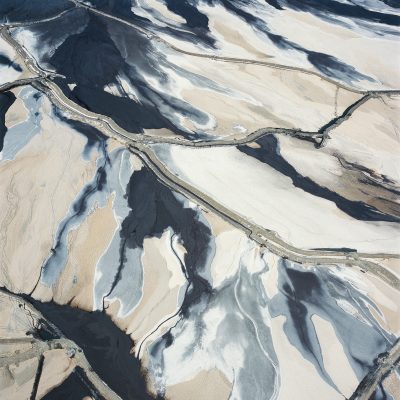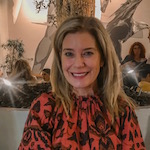During the initial quarantine, local and globally-celebrated aerial photographer and friend David Maisel began experimenting with large scale paintings in a studio at the Headlands Center for the Arts, a magnificent space in the Marin Headlands of Golden Gate National Recreation Area that offers residency programs for international artists in need of the gift of time and space for their creative process.
Before the holidays in December, I visited David in his new studio when he was in his third month of being engrossed in his new practice. I witnessed his artistic transition from photographs to paintings in person. We sipped coffee surrounded by his lovely creations inside the historic walls of Headlands Center for the Arts.
David discussed his personal history, art techniques, and world affairs that influenced his compositions. He shared that his themes are similar in his photography and painting practices – poignant concerns for the environment, landscape, and abstraction.
Below is a conversation from a follow-up email exchange after our time together in Sausalito.
I was raised in the suburbs of New York City, and did my undergrad and first round of graduate school in the northeast. I’d always been attracted to San Francisco as an idea, as a place for reinvention, before I’d ever visited here. My wife and I were living in New York City in the early 90’s, and had decided to move to the Bay Area; we craved nature in our daily lives in ways that New York did not allow. By sheer good fortune, we found a little jewel box of a house to rent in Muir Beach, facing toward the Pacific Ocean. It was the most beautiful introduction to living here we could have imagined.
Well, I think I’ll be making both paintings and photographs from now on. I had painted when I was younger, and my study of art history has always informed my photographs. I began making paintings again during the initial quarantine in March 2020 — at first, using materials I had on hand in my studio, small abstract watercolors on handmade French paper, and now, large scaled works on linen that measure up to more than six by twelve feet.
The pandemic provided me the time to make this shift and delve into it deeply, but it is an arena I’d wanted to explore for quite a long time. During the initial months of the pandemic, and as the wildfire season kicked in during the summer of 2020, it became an ideal moment to refocus on a studio-based art practice that involved more internal exploration.
The constants are landscape, concerns for the environment, and abstraction.
I think both my aerial photographs and my paintings express the anxiety I feel about the world we live in. Since 2020, I’ve been making paintings that reflect global and local climate change events through abstraction — from the fires here in California to the floods in Germany this summer. But the paintings aren’t literal depictions; unless a viewer reads deeply into the titles or my artist statement, they may never realize that is the basis of these works. By their nature, the paintings are more open-ended than my photographs, which (although frequently abstract and without scale reference) depict the environments in which they are made.
As an undergrad student at Princeton, I was lucky to study closely with the photographer Emmet Gowin. He was kind, focused, and generous; he worked extremely hard, and he loved his family. Those qualities were essential early influences.
Studying art history as an undergrad, I was influenced by Earthworks artists such as Robert Smithson and Nancy Holt, as well as the photographers Lewis Baltz and Frederick Sommer. Later, I came to the work of artists like Jenny Holzer and Anselm Kiefer, among many others.
I tend to read in-depth about subjects I’m exploring and, in the case of photographic projects, sites I’ll be visiting. For example, with my most current photographic series on mining lithium and copper in Chile’s Atacama Desert, I researched the history of mining, plus theoretical critiques like Neil Brenner’s book Implosions/Explosions: Towards a Study of Planetary Urbanization and Paul Kingsnorth’s Confessions of a Recovering Environmentalist. With my most recent paintings, I’m going in several directions at once. On one hand, I am researching the history of wildfires and the current trend toward mega fires, while simultaneously spending time with the work of mid-20th century painters like Helen Frankenthaler, Joan Mitchell, and Richard Diebenkorn.

The experience that instilled the most terror was during the making of that Desolation Desert series — looking down from an aerial vantage point on massive interlinked tailings ponds on the periphery of a vast copper mine complex in the Atacama Desert. The scale and the toxicity of the site was completely overwhelming — and I felt a kind of terror, a deep-seated fear within my body, at the horror of it.
In 2008, I did an artist residency at the Headlands Center for the Arts. I occupied the same glorious studio space I had use of in the Fall of 2021. In my application for that earlier residency, I stated that I would make no photographs while at the Headlands —that I would concentrate on drawing. I spent my three months of that residency tracing the infinite number of cracks in the plaster walls of the studio. I didn’t immediately understand why I was compelled to do that—but, over time, I saw that I was making a kind of topographical map, and bearing a kind of witness to the history of that place, much as I did with my aerial photographs. That experience taught me to see the through lines in what might at first seem disparate aspects of my work.
In the Fall of 2021, I returned to work in that same studio. This time I embraced the volume of that space differently —I was there with the specific purpose of making large paintings, larger than I can make in my usual studio. Rather than working with my body pressed up against the walls as I did in 2008, I was working with my linen down on the floor, and constantly looking out the large windows to the landscape beyond. It was a much more expansive experience, and maybe it somehow reflects who I am now versus who I was then.
I‘ve always been highly aware of color, extremely sensitized to it and affected by it. It forms the basis some of my earliest childhood memories—the color of light changing as it passed through the edge of a curtain, for example. I think sensing color has helped make me finely attuned to landscape—to the varying colors of moss in a forest, to the shades of ash at Mount St Helens, even to the brilliant hues of cyanide staining the earth in an open-pit mine.
Although I started out as a black and white photographer, I began to hit my stride as an artist when I shifted to making color images—learning how to deploy color in a work of art, how one color and its relative strength or intensity affects another in a painting or photograph, how to engage with those relationships, how to let them draw me forward in the making of an artwork. And, as both a photographic printmaker and as a painter, I feel the expressive power of color.
Living near New York as a child, my family and I would visit MOMA, the Whitney, and the Guggenheim Museum. I recall being especially entranced by the paintings of Mondrian, Jackson Pollack, and Van Gogh. My first experience with art where I felt compelled to become an artist myself probably happened at age 16, standing in front of a Frank Stella pinstripe painting at the Addison Gallery of Art. I could not understand it, but I also couldn’t get it out of my mind.
It took me a while to get to the point of considering myself an artist, though — at first I wanted to be an architect, in part because that seemed a more “legitimate” endeavor. But painting and photography are more capable of directly accessing ways of working with light, color, and form — and political and environmental content as well.
Concern for the environment and a fascination with beauty in all its forms.
Website: davidmaisel.com
Instagram: @davidmaiselstudio

Jennifer Wechsler serves on boards at UCLA ARTS and the Marin MOCA Museum. She also is a curator for FAULTline Art Shows exhibiting emerging and established artists in unique spaces and owner of TessutoEditions.